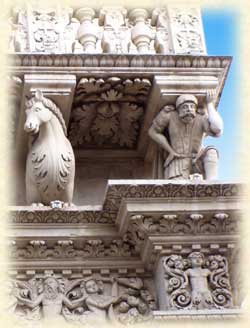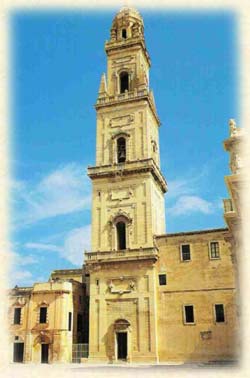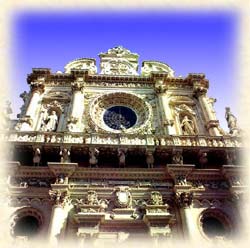|
|

|
|
|
| |
| LECCE |
|
| The Florence |
| of the Baroque |
|
| The prevailing style is, as it's known,
the Baroque, which takes on here such graceful forms and
such particular features you can't find anywhere else. |
|
Because of this characteristic it has been called the
Florence of the Baroque, as Gregorovius defined it. |
| The monuments of the Chief Town of
Salento form a patrimony which rightly arouses the
passionate admiration of all visitors and which few
cities can offer. |
| |
| |
| This is a city which, at every
turn, offers the visitors the surprise of a
doorway, a gallery, a small arch, a mullioned
window of charming workmanship. |
|
|
| It consists mainly of buildings constructed
between the end of the 16th century, when the Reinaissance
style was going to be replaced by the Baroque,
and the early 18th century, when the Baroque was begining
to take on more restrained forms. |
| It was during this period that Lecce was
endowed, thanks to the patronage of the Church, with its
most magnificent ecclesiastical buildings, in the
construction of which masters and artisans, the former in
planning, the latter in carring out these plans, vied for
brilliance and creativa spirit. |
| In this way there arose the complex of
Piazza del Duomo, the Basilica del Rosario, the Churches
of Santa Chiara, San Matteo, Della Grazia and the Basilica
of Santa Croce: the most important monument of the period. |
| |
| Worthy of special attention is the
monumental complex of Piazza Duomo, (Cathedral
Square), composed of the Cathedral (G.
Zimbalo 1659-70) and the adjacent Bell Tower (G.
Zimbalo 1661-82), the Bishop's Place and The
Seminary. |
|
|

|
|

| The building, begun in 1549 by the architect and
sculptor Gabriele Riccardi of Lecce, was completed in
1689 by Giuseppe Zimbalo and Cesare Penna. |
|
|
|
|
THE BASILICA
|
|
OF SANTA CROCE |
| |
| The basilica of Santa Croce is the most
characteristic expression of the Baroque of Lecce. The first impression of the
facade, the
ornaments of which are particularly conspicuous, really
takes your breath away. |
| Restained, if not sober, in the
lower part, with its six robust columns and the
ornamented doorway, the central and upper part of the
facade is full of such splendid decorations that you do
not know where to look at. |
| Even more than the facade, the interior
is serene, didnified, inviting. The naves soar to a
great hight, surmounted by the large dome, the
cross-vaults unite with extraordinary elegance, the
columns open into capitals of quaint originality. |
|
|
|
|
 |
|
________________________________________________________________________________ |
|
[ Welcome
] [ Always
original ] [ Location
] [ Contact
] [ Links
] |
|
|
|